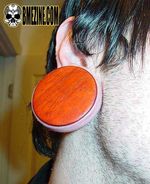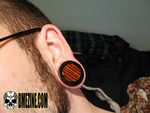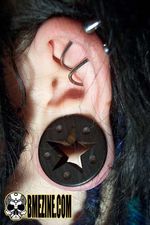Transurethral Piercing and Wooden jewelry: Difference between pages
(Page conversion via llm-mediawiki-rev -jwm) |
(Page conversion via llm-mediawiki-rev -jwm) |
||
| Line 1: | Line 1: | ||
[[File:Wood-1.jpg|thumb|right|150px|Wood]] | |||
[[File:Wood-2.jpg|thumb|right|150px|Wood]] | |||
[[File:Wood-3.jpg|thumb|right|150px|Wood]] | |||
Many hardwoods— [[Ebony|ebony]] being the most common example, other woods such as [[Chakte kok|chakte kok]], as well as woody grasses including [[Bamboo|bamboo]]— make excellent [[Jewelry|jewelry]]. While wooden jewelry works best in dry piercings, it has been used successfully in [[Tongue piercing|tongue piercings]] as well. Properly finished wood jewelry has a tendency to thicken the skin of a piercing and drastically improve its health over metal or plastic [[Body jewelry|body jewelry]]. A small percentage of individuals have (or develop) a [[Wood Allergy|wood allergy]] to certain kinds of wood. In addition, many hardwoods are considered endangered, and care should be taken to ensure that jewelry is obtained ethically. | |||
Common woods used in body jewelry: | |||
* [[Boxwood|Boxwood]] | |||
* [[Charcoal wood|Charcoal wood]] | |||
* [[Bamboo|Bamboo]] | |||
* [[Chakte Kok|Chakte Kok]] | |||
* [[Ebony|Ebony]] | |||
* [[Maple|Maple]] | |||
* [[Olive|Olive]] | |||
* [[Pink Ivory|Pink Ivory]] | |||
* [[Purple Heartwood|Purple Heartwood]] | |||
* [[Zebrawood|Zebrawood]] | |||
* [[Bloodwood|Bloodwood]] | |||
and many others. | |||
Some people finish their wooden jewelry using [[Wax|wax]], but many prefer simply oiling the wood using [[Olive oil|olive oil]], [[Vitamin E|Vitamin E]] oil, or [[Emu Oil|Emu Oil]]. '''DO NOT''' use varnishes, since that defeats the purpose of using wooden jewelry in the first place. You may also want to sand your wooden jewelry periodically. | |||
It should also be noted that wearing wooden jewelry in the shower can cause the wood to expand. If this happens, you may want to sand the jewelry until you can run your fingernail against it without feeling the grain. Once this has been done, you should re-oil the jewelry as well. | |||
== See Also == | == See Also == | ||
* [[ | * [[Organic|Organic]] | ||
* [[Wood Allergy|Wood Allergy]] | |||
* [[Wood Hazards|Wood Hazards]] | |||
Latest revision as of 22:51, 25 September 2023
Many hardwoods— ebony being the most common example, other woods such as chakte kok, as well as woody grasses including bamboo— make excellent jewelry. While wooden jewelry works best in dry piercings, it has been used successfully in tongue piercings as well. Properly finished wood jewelry has a tendency to thicken the skin of a piercing and drastically improve its health over metal or plastic body jewelry. A small percentage of individuals have (or develop) a wood allergy to certain kinds of wood. In addition, many hardwoods are considered endangered, and care should be taken to ensure that jewelry is obtained ethically.
Common woods used in body jewelry:
- Boxwood
- Charcoal wood
- Bamboo
- Chakte Kok
- Ebony
- Maple
- Olive
- Pink Ivory
- Purple Heartwood
- Zebrawood
- Bloodwood
and many others.
Some people finish their wooden jewelry using wax, but many prefer simply oiling the wood using olive oil, Vitamin E oil, or Emu Oil. DO NOT use varnishes, since that defeats the purpose of using wooden jewelry in the first place. You may also want to sand your wooden jewelry periodically.
It should also be noted that wearing wooden jewelry in the shower can cause the wood to expand. If this happens, you may want to sand the jewelry until you can run your fingernail against it without feeling the grain. Once this has been done, you should re-oil the jewelry as well.


